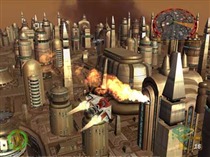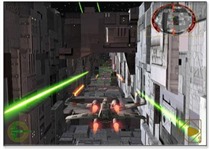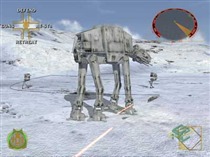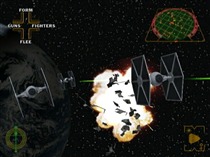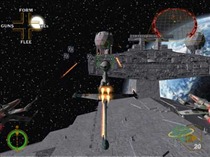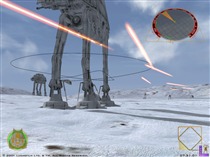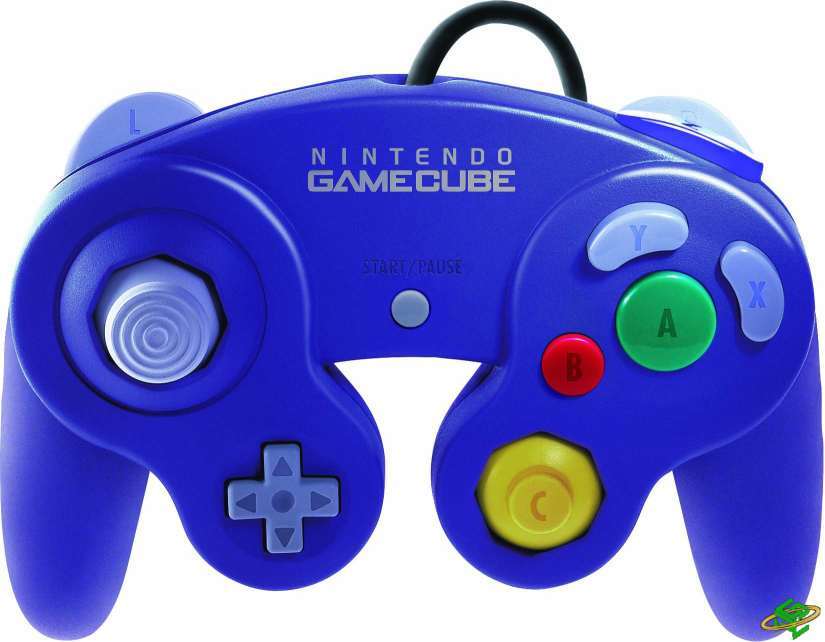We take a look back at the games worthy enough to be considered the GameCube's best.


Star Wars Rogue Squadron II: Rogue Leader
Released November 18, 2001 (GameCube launch title)
Developed by Factor 5
Published by Nintendo
Retrospective by Evan Burchfield
Star Wars Rogue Squadron II: Rogue Leader set a precedent for GameCube's potential that was never fully realized. It was the system's de facto killer app at launch, easily outshining Luigi's Mansion and the sports ports that dominated GameCube's early weeks. Though it was quickly topped by Nintendo's launch follow-up releases, Rogue Leader's success seemed to indicate a return to form for third party Nintendo games, as though an independent developer could compete and stand alongside Nintendo's best. This success was scarcely replicated again – few other third-party games remind us so much of an internally developed Nintendo game in terms of polish, gameplay, and replayability. As such, Rogue Leader was the call to arms for the GameCube revolution that never happened.
Developed in under nine months by Factor 5 and boasting graphics that Nintendo fans had been dreaming about since Project Reality, Rogue Leader was one of the most impressive games of 2001. The gameplay had already been established in the successful Rogue Squadron for the N64, but the processing power of GameCube allowed the developer to ratchet up the speed and intensity of the action. Hundreds of ships adorned the Battle of Endor level, and Razor Rendezvous looks busy (and is tough as hell) even today. Graphically speaking, Rogue Leader was a very innovative game: Volumetric fog was a buzzword bandied about at GameCube's launch, and to this day I can't recall another game that used it as much as Rogue Leader. It was also the first GameCube game to use cel-shading, and one of the first video games to utilize it for gameplay.
Just like the original Rogue Squadron, Rogue Leader's ship-based gameplay was never deep, but it was always compelling. Some levels let you take down Star Destroyers while others had you roping AT-ATs. One level had different objectives depending on the time of day you played, thanks to GameCube's internal clock. The game only featured ten full levels, but almost all of them were extremely hard. The game assumed you had mastered the simple control scheme by the end of the second level and quickly ramped up the difficulty all the way to the end. The game must have seemed appealing to the less-hardcore Star Wars fans who merely wanted to fly over Bespin or join in the Death Star attack, but I doubt most of them got past the halfway point. Those who did eventually beat the relatively short game were challenged to get a Gold Medal score on every level, a truly difficult and impressive feat.
The GameCube controller's best and least used innovation was fully utilized by Factor 5 in Rogue Leader. The pressure sensitive L and R buttons were actually two buttons in one, hiding an extra "click" after they were completely depressed. Rogue Leader used these buttons for speeding up and slowing down respectively, with the "click" functioning as a boost, brake, or S-Foil control depending on which ship you flew. Rogue Leader's usage of L and R was inventive, again setting the stage for innovative gameplay that never happened again.
At times, Rogue Leader did for Star Wars fans what George Lucas's new trilogy never did: It rekindled the magic of watching Star Wars for the first time. The game's best tactic was to utilize voices from the movies (and when necessary, authentic-sounding voice actors) and the original Star Wars soundtrack. All the vital themes from the first three films are played here, but thanks to Factor Five's revolutionary MusyX system the sound designers were able to weave their own original MIDI compositions with the classic recordings of John Williams. As you flew over various areas on the many planets you visit, the music would seamlessly change. Rogue Leader is just as much an aural masterpiece as it is a graphical achievement.
As Nintendo veers away from graphical superiority with Wii, it is interesting to note that the GameCube's first games were amazing to look at. Even today, Rogue Leader is a beautiful game, but more importantly it is just as fun as it was over five years ago. It is GameCube's quintessential pure action game, and one of the best Star Wars games ever made. And it has the best Hoth level ever.
Thoughts From the NWR Staff
Daniel Bloodworth: "Rogue Leader was the first GameCube game I got to play (since I found a local shop selling modded Japanese Cubes). It was and still is an amazing presentation of what the GameCube is capable of graphically. Thankfully, that level of quality was matched in the intense firefights and varied missions the game had to offer. I can also still remember being blown away by the implementation of the GameCube's internal clock to create day/night variations in a few of the levels based on the time of the day in the real world."
Mike Sklens: "I remember seeing this demo where they recreated the intro to The Battle of Yavin. Amazing. I looked just like Star Wars. I knew I had to have this game from that moment. Thankfully, the game behind all of this was equally amazing, fully engulfing the player in the Star Wars universe."
Steven Rodriguez: "For me, it had to be just being able to look around in the cockpit with the C-Stick. It gave you the feeling you were that person in control of the X-Wing, and not just a passenger in it. It was also really useful for taking a look around to get a better look of where you're going before you got there. The best part was looking over to the side during the Death Star trench run and seeing the wall zip by, trying to not look where you were going for as long as possible. Good times."
David Trammell: "Amazingly, RSII was developed in a mere nine months and remains the best GameCube tech-demo. A few other games look better due to exceptional art direction, but how many other games used so many texture layers and effects on so many surfaces? Only one that I know of: Rogue Leader's sequel."
Jonathan Metts: "Rogue Leader is an exceptional, hardcore action game that was easily my most heavily played launch title. How sad that its sequel is so uneven and uninspired."
Lasse Pallesen: "I guess any Nintendo fan would agree that booting up a new Nintendo console for the first time is a special experience. I clearly remember when I turned on my GameCube for the first time and heard the Star Wars theme coming from my speakers. I had heard it a thousand times before, but this time was special. This was next generation. Seeing the game in action only served to make the excitement stronger. The explosions of the towers on the Death Star totally blew me away. As did the AT-AT's on Hoth. And the cloud effects on Bespin. And the final battle of Endor. And... well, everything else. I'm still baffled how Factor 5 managed to squeeze so much out of the GameCube hardware so early on. Rogue Leader certainly didn't look like a typical first generation title. The game also controlled well and had varied level design. Overall, I definitely think Rogue Leader was the killer-app of the GameCube launch games - and I'm not just saying that because I'm a huge Star Wars fan."
Rogue Leader offered many gamers their first chance to try Nintendo's new controller, and although it doesn't seem quite so revolutionary today, it did have a few features that made it stand out at the time. Most significant were the analog L and R buttons "extra click" whose usage in Rogue Leader was inspired, but in most later games was unimpressive. These buttons were of great interest to Nintendo fans since they indicated new possibilities for gameplay design, but it seems developers (even Nintendo) ultimately didn't care about them. Only a scant few other GameCube games used the shoulder buttons' analog and click functions together, and rarely was it successful – third party games often assigned vital functions to the bottom click, but nothing to the analog press, forcing you to push the button all the way down. Even Nintendo's controversial The Legend of Zelda: Wind Waker avoided their full functionality. Unsurprisingly, Nintendo has ditched this good but underused idea on Wii – none of the Wii Remote or Nunchuk's buttons are analog.
Another subtle but vitally important innovation was that of raised and shaped buttons. As a response to the Sony PlayStation controller and Nintendo's own controller for N64, the GameCube controller featured four face buttons of different shapes and heights. Since the X and Y buttons were shaped like kidney beans and were taller than A and B, it wasn't easy to confuse them. Sony and Microsoft both have ignored this innovation and continue to design controllers with four face buttons of equal size and height. Nintendo's new Wii controller doesn't cluster buttons together, so shape and height differentiation was only used for the C and Z buttons on the Nunchuk. Nintendo also oversized the A Button on the GameCube controller to differentiate it from the smaller and less used B Button. (When it was unveiled, Shigeru Miyamoto said he would like to make a game using only the A Button; he eventually did, resulting in Kirby Air Ride.) The Z Button was also an interesting choice by Nintendo – they chose to make the button difficult to press to discourage its use as an action button. It was designed as a menu button, and for the most part developers have programmed accordingly, just as they had with C-Button and C-Stick camera control. Several games have used the Z Button as a quick-map, but in Rogue Leader it allowed you to roll your ship.
